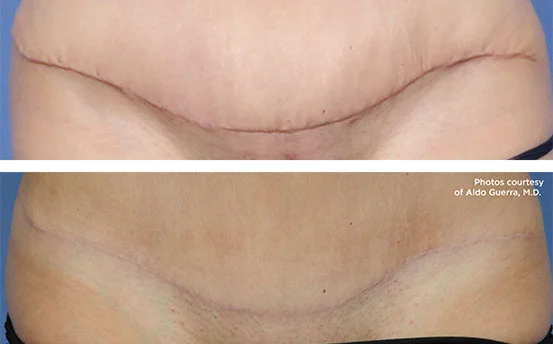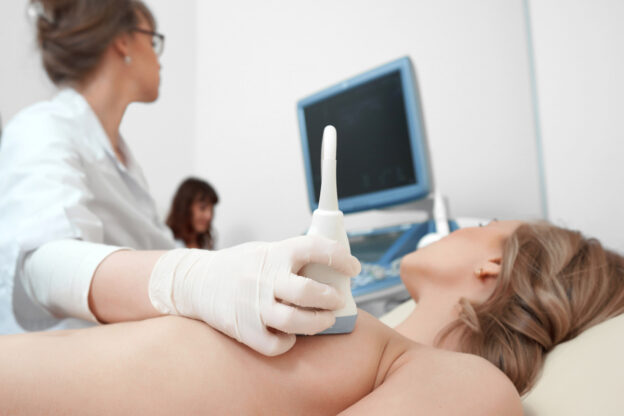4 Tips to Help Your Plastic Surgery Scars Heal Beautifully

Plastic surgery requires incisions, making postoperative scar care an important part of every patient’s recovery process. While many patients have little-to-no visible evidence they underwent a procedure by the time healing is complete, others may experience more pronounced scarring.
Fortunately, there are steps you can take to help your plastic surgery scars heal beautifully. Here, female Board-Certified Plastic Surgeon Dr. Emily J. Kirby shares factors that contribute to poor scarring, tips to achieve a more optimal scar appearance, and treatments that can minimize existing scars.
Factors that contribute to poor scarring
Physiological and environmental factors can contribute to a poor scar appearance, including:
- Genetics. Some people are genetically predisposed to developing more noticeable scars, as genetics affect how your skin heals from incisions or trauma.
- Age. Older patients may need more time to recover from plastic surgery and may experience more obvious scarring.
- Skin type. Patients with darker skin tones are more prone to developing keloid scars, which are raised and can be discolored.
- Conditions. Patients who smoke and have increased sun exposure are likely to scar poorly, as are diabetic patients and patients taking steroids. All of these conditions delay healing, contributing to poorly healed scars.
- Location. Incisions in certain areas of the body may be more likely to be put under stress, which can widen the scar.
- Technique. The incision technique used by your plastic surgeon also affects scarring in high-surface tension areas.
Tips to help your plastic surgery scars heal beautifully
Fortunately, there are ways to minimize the final appearance of your plastic surgery scars, starting with your choice of surgeon. It is critical that you choose a board-certified plastic surgeon trained in advanced techniques to achieve optimal results while minimizing scarring.
Remember to be patient and consistent with scar care; surgical scars may take over a year to fade to their final appearance.
After surgery, responsibility largely shifts to the patient. Following postoperative instructions closely is highly recommended, as proper care reduces scar visibility. Here are the most effective ways to help your scars disappear over time:
1. Follow post-surgery instructions
It is essential to follow all recovery guidelines. One of the most fundamental postoperative rules is to not strain your incision(s), especially during the initial healing process within the first 6 weeks. While you may feel great within a few weeks after surgery, your body goes through the four processes of wound healing for much longer than it takes to feel back to normal.
Stages of scar healing include:
- Hemostasis (0 to 24 hours after injury or surgery)
- Inflammation (1 day to 2 weeks after injury or surgery)
- Proliferation (4 days to 3 weeks after injury or surgery)
- Remodeling (3 weeks to 1 year after injury or surgery)
These processes naturally overlap and are supported when you follow recovery guidelines, but can easily be impaired if strain or stretch is placed on incisions too early in the healing process. Seroma development (fluid build-up under the skin) is another factor that can stress a suture line; your surgery team watches for this at your postoperative appointments. The transition between the initial inflammatory and proliferative phases (when the body restores blood vessels and forms new tissue) is especially key as an extended inflammatory stage is associated with increased scarring.
2. Protect your skin from the sun
New scars are more sensitive to UV damage for a full year after surgery. Exposure to sunlight can disrupt the normal phases of wound healing, leading to a longer recovery time and more visible scarring. You must vigilantly protect your skin from UV exposure and other environmental factors that may cause damage. Regular use of a mineral-based (containing zinc and/or titanium) sun block of at least SPF 30 and UPF protective clothing help avoid permanent discoloration as your scar matures.
3. Use a silicone scar treatment
Several over-the-counter scar creams claim to minimize scars; however, silicone is the only substance proven to reduce the appearance of scars. You can apply silicone sheeting or a silicone-based scar care gel once the incision heals. You have a few options for silicone scar treatments, and depending on the incision site, your surgeon may recommend one over the other:
- Silicone sheets can be cut into strips for a custom fit. Silicone strips gently stick to your scar and are a great option if you need to cover a larger area or prefer less maintenance, as they can be worn at all times unless showering. Embrace® Active Scar Defense is FDA-cleared and is proven to relieve tension around incisions to prevent raised scars from forming.
- Silicone-based gels may be a better option to use in more mobile areas or for scars along contours where a silicone sheet will not easily adhere. Most patients also prefer silicone scar gel for more visible parts of their body (face, neck, hands, etc.). Scar care gel is typically applied 2-3 times a day. BIOCORNEUM® scar treatment contains medical-grade silicone and SPF 30 for optimal healing and protection benefits.
For ideal results, expect to use scar care products for at least 8 weeks, or until the scar has stabilized, thinned out, and lays flat. If your scar is not satisfactory after 8 weeks, you can use these products for up to 12-18 months and see improvement. After this time, the scar is usually established and is not likely to change with conservative (non-surgical) treatment.

4. Massage your scars
Scar massage can help prevent adhesion (when scar tissue attaches to something it is not normally connected to), which causes scars to raise and thicken or pucker. Preventing adhesion can improve the appearance and mobility of the scar. Following your surgeon’s instructions, massage healed incision sites several times a day for 3-5 minutes; decreasing friction in the area with an oily cream (Bio-oil, Eucerin, Mederma, etc.) will make the massage more comfortable and promote quicker wound healing.
Treatment options for reducing the appearance of existing scars
We offer a variety of treatments at our Fort Worth medical spa at Kirby Plastic Surgery to help improve the appearance of scars. Under the direction of Fort Worth Board-Certified Plastic Surgeon Dr. Emily Kirby, our team of aesthetic specialists are highly experienced in treatments to improve the appearance of nearly all skin imperfections, including proven ways to reduce the appearance of scars.
Recommended scar reduction techniques include:
- SkinPen® Microneedling improves the appearance of scars by increasing collagen and elastin production via micro-punctures in the skin’s surface. A study published in Plastic and Reconstructive Surgery® in 2022 showed a significant improvement in scar appearance when treatments began within 6-7 weeks of surgery.
- Laser skin resurfacing delivers targeted light energy to stimulate cell repair within the scar tissue, encouraging collagen and elastin remodeling. Numerous studies show remarkable results, with some patients experiencing a 57-83% improvement in the appearance and texture of surgical scars.
At Kirby Plastic Surgery, our team is dedicated to supporting patients through every step of their journey, from a highly informative initial consultation, to safe and effective scar care treatments after surgery. We would love to meet with you to discuss your aesthetic goals and develop a treatment plan for you. To learn more about body contouring for beautiful proportions, breast augmentation to create feminine cleavage, or any of our other plastic surgery and medical spa services, we invite you to call or text (817) 292-4200 or contact us online.



Thank you for educating us. Nobody wants scars, and knowing this will be a great help! Keep on posting!